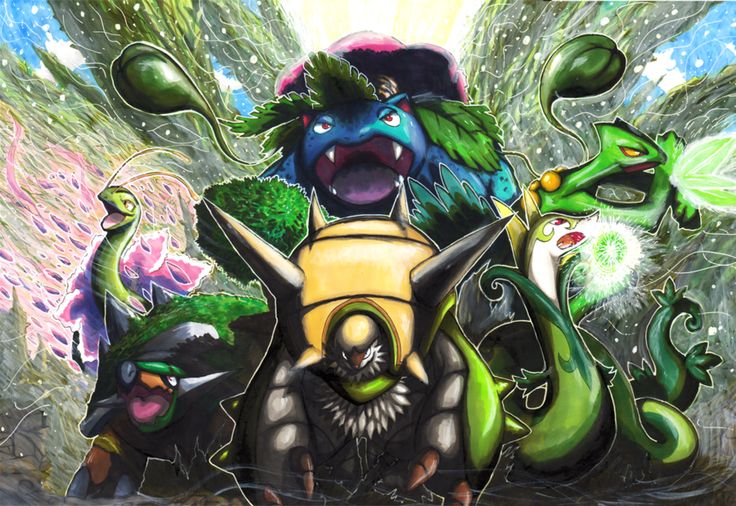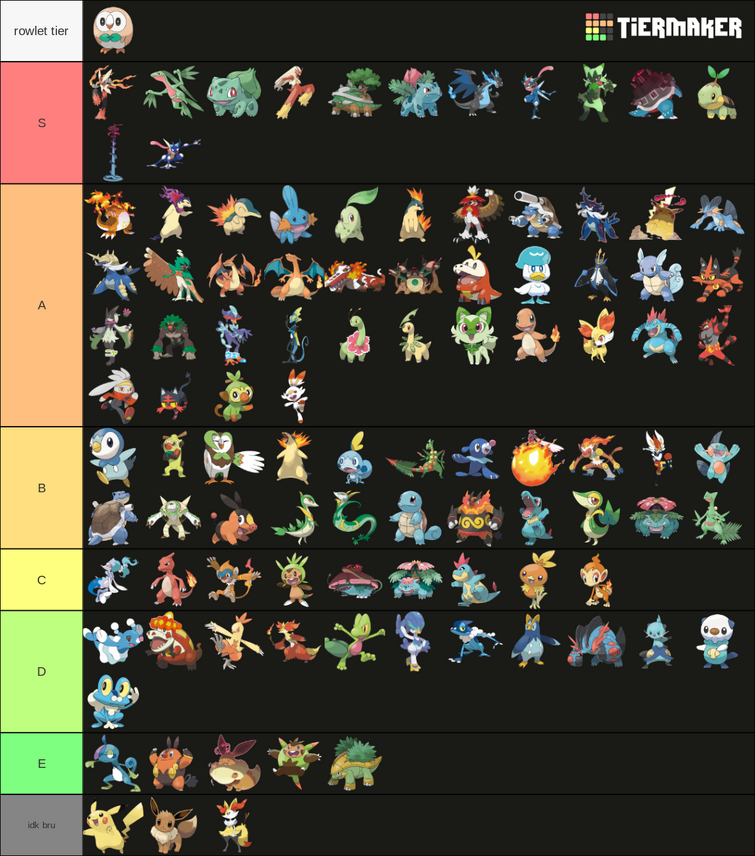Comparing The Best Grass-Type Pokémon Starters Throughout The Generations

Table of Contents
Generation I: Bulbasaur - The Classic Choice
Bulbasaur, the iconic Grass/Poison-type starter from Generation I, remains a popular choice for many trainers. Its dual typing provides an early-game advantage, offering effective coverage against several common early-game opponents.
-
Strengths: Bulbasaur's dual typing (Grass/Poison) gives it a strong early-game advantage. Its evolution, Venusaur, boasts high special attack and access to powerful moves like Solar Beam and Sludge Bomb. Venusaur's bulk also makes it a formidable opponent.
-
Weaknesses: Bulbasaur and its evolutions are vulnerable to Fire and Flying-type moves, a common weakness among Grass-types.
-
Evolutionary Line: Bulbasaur evolves into Ivysaur at level 16 and then into Venusaur at level 32. This evolution provides significant stat boosts and access to new moves.
-
Competitive Viability: Venusaur remains a competitively viable Pokémon, often utilized for its powerful special attack and supportive moves like Synthesis and Pollen Puff. Its ability, Chlorophyll, doubles its speed in sunshine, further enhancing its performance.
-
Overall Role: Bulbasaur serves as a solid all-around starter, excelling in both offensive and defensive roles. Its dual typing and powerful evolution make it a reliable choice for any trainer.
Generation II: Chikorita - The Timid Seed
Chikorita, the Grass-type starter from Generation II, presents a different approach. While initially appearing weaker than other starters, its evolution, Meganium, offers a unique supportive role.
-
Strengths: Chikorita's evolutionary line focuses on bulk and support. Meganium boasts high HP and defense stats, making it a sturdy tank. It also learns supportive moves like Aromatherapy and Synthesis.
-
Weaknesses: Chikorita and Meganium possess a significant weakness to Fire, Ice, Poison, Bug, and Flying-type moves. This wide range of vulnerabilities requires careful team composition.
-
Evolutionary Line: Chikorita evolves into Bayleef at level 16 and then into Meganium at level 32.
-
Competitive Viability: While not as offensively potent as other Grass-type starters, Meganium's supportive abilities and bulk make it a valuable asset in specific competitive team strategies.
-
Overall Role: Chikorita shines as a supportive tank, its role differing significantly from the more aggressive Grass-type starters in other generations.
Generation III: Treecko - The Agile Ninja
Treecko, the Grass-type starter from Generation III, stands out for its speed and agility. Its evolution, Sceptile, is a powerful special attacker, but its physical attack isn't to be scoffed at either.
-
Strengths: Treecko evolves into the fast and powerful Sceptile. Its high speed stat makes it excel in speed-based strategies. Sceptile has good access to both physical and special attacks.
-
Weaknesses: Treecko and Sceptile share vulnerabilities against Ice, Fire, Poison, Flying, Bug, and Dragon types, requiring strategic maneuvering in battle.
-
Evolutionary Line: Treecko evolves into Grovyle at level 16 and then into Sceptile at level 36.
-
Competitive Viability: Sceptile's speed and powerful moveset make it a viable competitive choice, especially with access to moves like Leaf Blade and Dragon Pulse.
-
Overall Role: Treecko's versatile nature allows it to be built as either a physical or special attacker, offering more flexibility in team composition.
Generation IV: Turtwig - The Sturdy Defender
Turtwig, the Grass/Ground-type starter from Generation IV, is a defensive powerhouse. Its evolution, Torterra, is known for its remarkable tankiness.
-
Strengths: Turtwig's evolutionary line, culminating in Torterra, possesses high defense and special defense stats. Torterra's Ground-type secondary typing provides crucial coverage against Electric and Rock-type opponents.
-
Weaknesses: Torterra’s weaknesses include Fire, Water, Ice, and Fighting types. This makes it susceptible to common attacking types.
-
Evolutionary Line: Turtwig evolves into Grotle at level 18 and then into Torterra at level 32.
-
Competitive Viability: Torterra's high defenses and Ground-type coverage make it an excellent defensive wall in competitive battles. However, its lower speed can be a drawback.
-
Overall Role: Turtwig excels as a defensive tank and provides valuable support to offensive teammates.
Generation V: Snivy - The Graceful Serpent
Snivy, the Grass-type starter of Generation V, is known for its elegant design and powerful special attack. Its evolution, Serperior, is a sleek and powerful special attacker.
-
Strengths: Snivy's evolution, Serperior, boasts a strong Special Attack stat and high speed. This combination makes it a formidable offensive threat.
-
Weaknesses: Serperior maintains the typical Grass-type vulnerabilities to Fire, Ice, Flying, Poison, and Bug types.
-
Evolutionary Line: Snivy evolves into Servine at level 17 and then into Serperior at level 36.
-
Competitive Viability: Serperior's high speed and powerful STAB (Same-Type Attack Bonus) moves make it a consistent threat in competitive battles.
-
Overall Role: Snivy fulfills the role of a swift and powerful special attacker, dealing significant damage to opponents.
Generation VI: Chespin - The Spiky Hedgehog
Chespin, the Grass-type starter from Generation VI, is a physical powerhouse. Its evolution, Chesnaught, is a bulky physical attacker.
-
Strengths: Chespin evolves into the defensive powerhouse Chesnaught. It boasts high Defense and Attack stats, making it both durable and offensively strong.
-
Weaknesses: Chesnaught's weaknesses include Flying, Fire, Ground, Ice, and Psychic types, making it vulnerable to a variety of common moves.
-
Evolutionary Line: Chespin evolves into Quilladin at level 16 and then into Chesnaught at level 36.
-
Competitive Viability: Chesnaught's bulk and physical attack make it a decent choice for competitive battles, especially when taking advantage of its high Defense.
-
Overall Role: Chesnaught functions as a sturdy physical attacker capable of taking hits while dishing out significant damage.
Generation VII: Rowlet - The Owl Pokémon
Rowlet, the Grass/Ghost-type starter from Generation VII, stands out with its unique dual typing. Its evolution, Decidueye, is a powerful special attacker with a unique play style.
-
Strengths: Decidueye’s Ghost/Grass typing provides some unique resistances, and its powerful special attack and speed make it a dangerous opponent.
-
Weaknesses: Decidueye's unique typing does not negate many weaknesses, and remains vulnerable to Fire, Ice, Flying, Poison, Ghost, Bug, Dark, and Dragon types. Its high special attack stat is important to exploit.
-
Evolutionary Line: Rowlet evolves into Dartrix at level 17 and then into Decidueye at level 34.
-
Competitive Viability: Decidueye is a popular competitive choice thanks to its speed and powerful special attacks, often used in various strategies.
-
Overall Role: Decidueye is a powerful special attacker with a unique typing, offering strategic advantages in both PvE and PvP.
Generation VIII: Grookey - The Drumming Monkey
Grookey, the Grass-type starter from Generation VIII, is a powerful physical attacker. Its final evolution, Rillaboom, brings powerful offensive capabilities and supportive potential to the table.
-
Strengths: Grookey evolves into the hard-hitting Rillaboom, known for its high physical attack stat and access to powerful Grass-type moves. Rillaboom also has access to supportive moves.
-
Weaknesses: Rillaboom shares many of the standard Grass-type weaknesses: Fire, Ice, Flying, Poison, Bug, Ice, and Dragon types.
-
Evolutionary Line: Grookey evolves into Thwackey at level 16 and then into Rillaboom at level 35.
-
Competitive Viability: Rillaboom's high attack and supportive abilities make it a viable competitive Pokémon, particularly in strategies that utilize its powerful offensive presence.
-
Overall Role: Rillaboom functions as a powerful physical attacker who can also provide support to its team.
Conclusion: Choosing Your Perfect Grass-Type Starter
Choosing the "best" Grass-type starter Pokémon is subjective and depends heavily on your playstyle and desired team composition. From Bulbasaur's classic charm to Rillaboom's powerful drumming, each generation offers a unique and compelling Grass-type option. By carefully considering their strengths, weaknesses, and evolutionary paths, you can make an informed decision that will lead you to victory. So, which Grass-type Pokémon starter will you choose for your next Pokémon journey? Begin your research now and discover the perfect Grass-type Pokémon starter for you!

Featured Posts
-
 Alexis Kohler Nouveau Vice President Executif De La Societe Generale
May 14, 2025
Alexis Kohler Nouveau Vice President Executif De La Societe Generale
May 14, 2025 -
 Section 230 And The Sale Of Banned Chemicals On E Bay A Legal Ruling
May 14, 2025
Section 230 And The Sale Of Banned Chemicals On E Bay A Legal Ruling
May 14, 2025 -
 Iscrizioni Trasporto Scolastico Sanremo Scadenze E Modulistica
May 14, 2025
Iscrizioni Trasporto Scolastico Sanremo Scadenze E Modulistica
May 14, 2025 -
 Estonian Eurovision Acts Italian Parody A Semi Final Surprise
May 14, 2025
Estonian Eurovision Acts Italian Parody A Semi Final Surprise
May 14, 2025 -
 Picking The Perfect Partner Best Starter Pokemon By Generation
May 14, 2025
Picking The Perfect Partner Best Starter Pokemon By Generation
May 14, 2025
